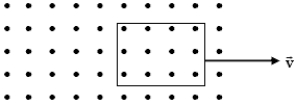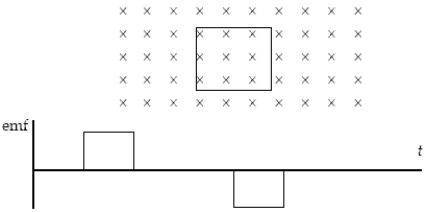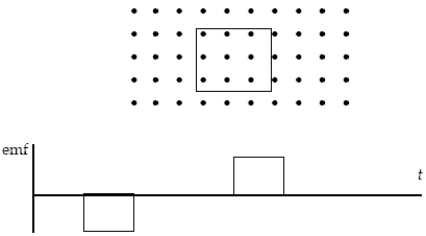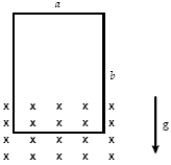A) The current in the loop always flows in a clockwise direction.
B) The current in the loop always flows in a counterclockwise direction.
C) The current in the loop flows first in a clockwise, then in a counterclockwise direction.
D) The current in the loop flows first in a counterclockwise, then in a clockwise direction.
E) No current flows in the loop because both ends of the magnet move through the loop.
Correct Answer

verified
Correct Answer
verified
Multiple Choice
A conducting bar of length L rotates in a counterclockwise direction with a constant angular speed of +2.0 rad/s about a pivot P at one end, as shown. A uniform magnetic field (magnitude = 0.20 T) is directed into the paper. If L = 0.40 m, what is the potential difference, VA − VB? 
A) +24 mV
B) −24 mV
C) +16 mV
D) −16 mV
E) +32 mV
Correct Answer

verified
Correct Answer
verified
Multiple Choice
In the arrangement shown, a conducting bar of negligible resistance slides along horizontal, parallel, frictionless conducting rails connected as shown to a 2.0-Ω resistor. A uniform 1.5-T magnetic field is perpendicular to the plane of the paper. If L = 60 cm, at what rate is thermal energy being generated in the resistor at the instant the speed of the bar is equal to 4.2 m/s? 
A) 8.6 W
B) 7.8 W
C) 7.1 W
D) 9.3 W
E) 1.8 W
Correct Answer

verified
Correct Answer
verified
Multiple Choice
In a demonstration, a 4.00 cm2 square coil with 10,000 turns enters a larger square region with a uniform 1.50-T magnetic field at a speed of 100 m/s. The plane of the coil is perpendicular to the field lines. If the breakdown voltage of air is 4000 V/cm on that day, the largest gap you can have between the two wires connected to the ends of the coil and still get a spark is
A) 7.5 × 10−3 cm.
B) 0.015 cm.
C) 7.5 cm.
D) 13 cm.
E) 15 cm.
Correct Answer

verified
Correct Answer
verified
Multiple Choice
A metal blade spins at a constant rate of 5.0 revolutions per second about a pivot through one end of the blade. This rotation occurs in a region where the component of the earth's magnetic field perpendicular to the blade is 30 μT. If the blade is 60 cm in length, what is the magnitude of the potential difference between its ends?
A) 0.24 mV
B) 0.20 mV
C) 0.17 mV
D) 0.27 mV
E) 0.34 mV
Correct Answer

verified
Correct Answer
verified
Multiple Choice
Coil 1, connected to a 100-Ω resistor, sits inside coil 2. Coil 1 is connected to a source of 60 cycle per second AC current. Which statement about coil 2 is correct?
A) No current will be induced in coil 2.
B) DC current (current flow in only one direction) will be induced in coil 2.
C) AC current (current flow in alternating directions) will be induced in coil 2.
D) DC current will be induced in coil 2, but its direction will depend on the initial direction of flow of current in coil 1.
E) Both AC and DC current will be induced in coil 2.
Correct Answer

verified
Correct Answer
verified
Multiple Choice
A conducting rod (length = 2.0 m) spins at a constant rate of 2.0 revolutions per second about an axis that is perpendicular to the rod and through its center. A uniform magnetic field (magnitude = 8.0 mT) is directed perpendicularly to the plane of rotation. What is the magnitude of the potential difference between the center of the rod and either of its ends?
A) 16 mV
B) 50 mV
C) 8.0 mV
D) 0.10 mV
E) 100 mV
Correct Answer

verified
Correct Answer
verified
Multiple Choice
As shown below, a square loop of wire of side a moves through a uniform magnetic field of magnitude B perpendicular to the page at constant velocity  directed to the right. Which statement regarding the electric field induced in the wires is correct for the wires at the left and right sides of the loop?
directed to the right. Which statement regarding the electric field induced in the wires is correct for the wires at the left and right sides of the loop? 
A) The electric field ![]() is directed upwards in both the right and left sides of the loop.
is directed upwards in both the right and left sides of the loop.
B) The electric field ![]() is directed upwards in the right side and downwards in the left side of the loop.
is directed upwards in the right side and downwards in the left side of the loop.
C) The electric field ![]() is directed upwards in the left side and downwards in the right side of the loop.
is directed upwards in the left side and downwards in the right side of the loop.
D) The electric field ![]() is directed downwards in both the right and left sides of the loop.
is directed downwards in both the right and left sides of the loop.
E) There is no electric field present in any side of the loop.
Correct Answer

verified
Correct Answer
verified
Multiple Choice
At what frequency should a 200-turn, flat coil of cross sectional area of 300 cm2 be rotated in a uniform 30-mT magnetic field to have a maximum value of the induced emf equal to 8.0 V?
A) 7.5 Hz
B) 7.1 Hz
C) 8.0 Hz
D) 8.4 Hz
E) 16 Hz
Correct Answer

verified
Correct Answer
verified
Multiple Choice
Starting outside the region with the magnetic field, a single square coil of wire enters, moves across, and then leaves the region with a uniform magnetic field  perpendicular to the page so that the graph shown below represents the induced emf. The loop moves at constant velocity
perpendicular to the page so that the graph shown below represents the induced emf. The loop moves at constant velocity  . As seen from above, a counterclockwise emf is regarded as positive. In which direction did the loop move over the plane of the page?
. As seen from above, a counterclockwise emf is regarded as positive. In which direction did the loop move over the plane of the page? 
A) The loop moved from bottom to top.
B) The loop moved from top to bottom.
C) The loop moved from left to right.
D) The loop moved from right to left.
E) All of these directions of motion will produce the graph of emf vs t.
Correct Answer

verified
Correct Answer
verified
Multiple Choice
A 40-turn circular coil (radius = 4.0 cm, total resistance = 0.20 Ω) is placed in a uniform magnetic field directed perpendicular to the plane of the coil. The magnitude of the magnetic field varies with time as given by B = 50 sin(10 πt) mT where t is measured in s. What is the magnitude of the induced current in the coil at 0.10 s?
A) 50 mA
B) 1.6 A
C) 0.32 A
D) zero
E) 0.80 A
Correct Answer

verified
Correct Answer
verified
Multiple Choice
Starting outside the region with the magnetic field, a single square coil of wire enters, moves across, and then leaves the region with a uniform magnetic field  perpendicular to the page so that the graph shown below represents the induced emf. The loop moves at constant velocity
perpendicular to the page so that the graph shown below represents the induced emf. The loop moves at constant velocity  . As seen from above, a counterclockwise emf is regarded as positive. In which direction did the loop move over the plane of the page?
. As seen from above, a counterclockwise emf is regarded as positive. In which direction did the loop move over the plane of the page? 
A) The loop moved from bottom to top.
B) The loop moved from top to bottom.
C) The loop moved from left to right.
D) The loop moved from right to left.
E) All of these directions of motion will produce the graph of emf vs t.
Correct Answer

verified
Correct Answer
verified
Short Answer
A 500-turn circular loop 15.0 cm in diameter is initially aligned so that its axis is parallel to the Earth's magnetic field. In 2.77 ms the coil is flipped so that its axis is perpendicular to the Earth's field. If a voltage of 0.166 V is induced in the coil, what is the value of the Earth's magnetic field?
Correct Answer

verified
Correct Answer
verified
Multiple Choice
An AC generator consists of 6 turns of wire. Each turn has an area of 0.040 m2. The loop rotates in a uniform field (B = 0.20 T) at a constant frequency of 50 Hz. What is the maximum induced emf?
A) 13 V
B) 2.4 V
C) 3.0 V
D) 15 V
E) 4.8 V
Correct Answer

verified
Correct Answer
verified
Multiple Choice
A small airplane with a wing span of 12 m flies horizontally and due north at a speed of 60 m/s in a region where the magnetic field of the earth is 60 μT directed 60° below the horizontal. What is the magnitude of the induced emf between the ends of the wing?
A) 50 mV
B) 31 mV
C) 37 mV
D) 44 mV
E) 22 mV
Correct Answer

verified
Correct Answer
verified
Multiple Choice
A flat coil of wire consisting of 20 turns, each with an area of 50 cm2, is positioned perpendicularly to a uniform magnetic field that increases its magnitude at a constant rate from 2.0 T to 6.0 T in 2.0 s. If the coil has a total resistance of 0.40 Ω, what is the magnitude of the induced current?
A) 0.70 A
B) 0.60 A
C) 0.50 A
D) 0.80 A
E) 0.20 A
Correct Answer

verified
Correct Answer
verified
Multiple Choice
A coil is wrapped with 300 turns of wire on the perimeter of a square frame (side length = 20 cm) . Each turn has the same area as the frame, and the total resistance of the coil is 1.5 Ω. A uniform magnetic field perpendicular to the plane of the coil changes in magnitude at a constant rate from 0.50 T to 0.90 T in 2.0 s. What is the magnitude of the induced emf in the coil while the field is changing?
A) 2.4 V
B) 1.6 V
C) 3.2 V
D) 4.0 V
E) 8.4 V
Correct Answer

verified
Correct Answer
verified
Multiple Choice
A current may be induced in a coil by
A) moving one end of a bar magnet through the coil.
B) moving the coil toward one end of the bar magnet.
C) holding the coil near a second coil while the electric current in the second coil is increasing.
D) all of the above.
E) none of the above.
Correct Answer

verified
Correct Answer
verified
Multiple Choice
A conducting bar of length L rotates with a constant angular speed of +2.0 rad/s about a pivot P at one end, as shown. A uniform magnetic field (magnitude = 0.20 T) is directed into the paper. If L = 0.40 m, what is the potential difference, VA − VP? 
A) −12 mV
B) +8.0 mV
C) −8.0 mV
D) +12 mV
E) −16 mV
Correct Answer

verified
Correct Answer
verified
Multiple Choice
A conducting rectangular loop of mass M, resistance R, and dimensions a × b is allowed to fall from rest through a uniform magnetic field which is perpendicular to the plane of the loop. The loop accelerates until it reaches a terminal speed (before the upper end enters the magnetic field) . If a = 2.0 m, B = 6.0 T, R = 40 Ω, and M = 0.60 kg, what is the terminal speed? 
A) 1.6 m/s
B) 20 m/s
C) 2.2 m/s
D) 26 m/s
E) 5.3 m/s
Correct Answer

verified
Correct Answer
verified
Showing 21 - 40 of 56
Related Exams